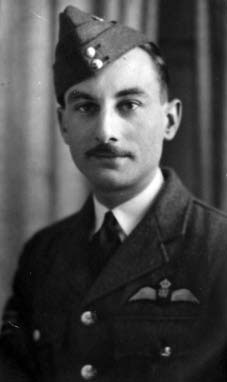Hampden X3022 at Lindholme airfield.
In the early hours of 17th November 1940 the crew of this 50 Squadron aircraft were tasked with flying an operation flight to Hamburg and had set out at 01.17hrs.
The aircraft flew into bad weather which caused the starboard engine to ice up at 9,500 feet, the pilot descended to one
thousand feet and after the engine had returned to normal he attempted to climb but encountered a severe snowstorm. The crew
opted to bomb a secondary target of Spiekebroog airfield in 10/10ths visibility. The crew turned for home but the
flare-path at Lindholme was unlit on their return which caused the pilot difficulty in finding the runway. The aircraft
swung on hitting the waterlogged grass and crashed, resulting in minor damage which was repaired on site. The crew escaped injury.
Pilot - Sgt Hubert Victor Crum RAFVR (740587).
Second Pilot - Sgt Linford Herbert Adams RAFVR (742983).
Wireless Operator / Air Gunner - Sgt McAlwane.
Wireless Operator / Air Gunner - Sgt Barley.
Linford Adams' medal set and service details were auctioned in 2007 by Spinks of London and the auction catalogue
gave extra details about his life. He was born in Hornsey, London in 1915 but was educated at Southend High School.
He joined the RAFVR in February 1939 and trained with 16 OTU from 4th May to 9th August 1940. He was posted to 106
Squadron based at Finningley for a brief period until 25th August 1940 when he was posted to Lindholme to 50 Squadron
to fly Hampdens. He flew twenty nine operational flights with 50 Squadron.
Prior to this auction catalogue being found extra details about four flying incidents were not fully known.
On 20th September 1940 he was returning from Ops and ordered to abandon his aircraft over Lincolnshire by his then
captain. He baled out and landed at Hemswell but his pilot was able to crash land nearby.
Sgt Adams thus qualified for the Caterpiller Club. On 17th November 1940 the incident recorded above occurred. His
logbook also mentions an incident on return from Ops to Kiel on 25th November 1940 when he "crashed" while returning
to base, his son was able to give extra information information that this occured near Saltfleet, Lincolnshire (and not
at Lindholme as was previously thought by this researcher). The crew escaped with minor injuries.
On completion of his Tour he was posted to 25 OTU to instruct on 28th February 1941. He was awarded
the DFM for service with 50 Squadron (Gazetted on 25th April 1941) but no citation has yet been found.
Sadly on the evening of 18th November 1941 F/Sgt Adams was the instructor on board Manchester L7428, the aircraft
crashed near Bawtry, South Yorkshire after suffering engine failure and sadly he lost his life as
a result of the accident. He was buried in Southend on Sea Cemetery, and was twenty six years old. This loss is also detailed on this website.

Sgt Crum was awarded the DFM for service with 50 Squadron, Gazetted on 7th March 1941. No citation has been found for this award as yet.
He was later posted to 44 Squadron and on the famous Augsburg daylight raid on 17th April 1942 when he was flying Lancaster L7548 the aircraft was shot down and he became a PoW.
Sgt McAlwane may have been one William Henry McAlwane RAF (654274), as F/Sgt he was later posted to 12 Squadron and
lost on 7th September 1942 flying in Wellington BJ777. The aircraft is believed to have crashed off France while mine laying. He is buried in Pornic War Cemetery, France.
Hampden X3022 was built to contract B.994449/39 by the English Electric Company Ltd, at Samlesbury and was awaiting collection in early October 1940. It was allotted to 12 MU on 2nd October 1940 and was received by them ten days later. The aircraft was taken on charge by 50 Squadron
at Lindholme on 26th October 1940. On 17th November 1940 it sustained this damage at Lindholme and Cat.M/FB damage was recorded after assessment. The aircraft was transported for repair at the Service Aircraft Section at Tollerton. The repair appears to have taken some months. It next appears being received by 8 MU on 1st August 1941 and was then flown to English Electric at Samlesbury to have modifications carried out on 11th November 1941. Once complete it was flown to 29 MU on 21st December 1941. It was flown back to English Electric on 24th April 1942 as it one of forty selected for conversion to TB.1 status. It was finally was then issued to 144 Squadron on 7th May 1942 at Leuchars in Coastal Command when the unit began working up for torpedo dropping. The aircraft was transferred to 455 Squadron RAAF at Leuchars on 30th October 1942 who were also working up in Coastal Command for torpedo dropping. On 5th September 1942 it was flown to Vaenga, Russia for operations in support of the convoy route to northern Russia and the following month it was transferred to the Russian Navy. It's AM Form 78 states that it was left in Russia on 1st November 1943 Nothing more is known of the aircraft after this transfer but an interesting and different end to an aircraft's history.
I thank Mr Paul Adams, son of Linford Adams for contacting me in December 2010 and for the additional information he was kind enough to provide this account.